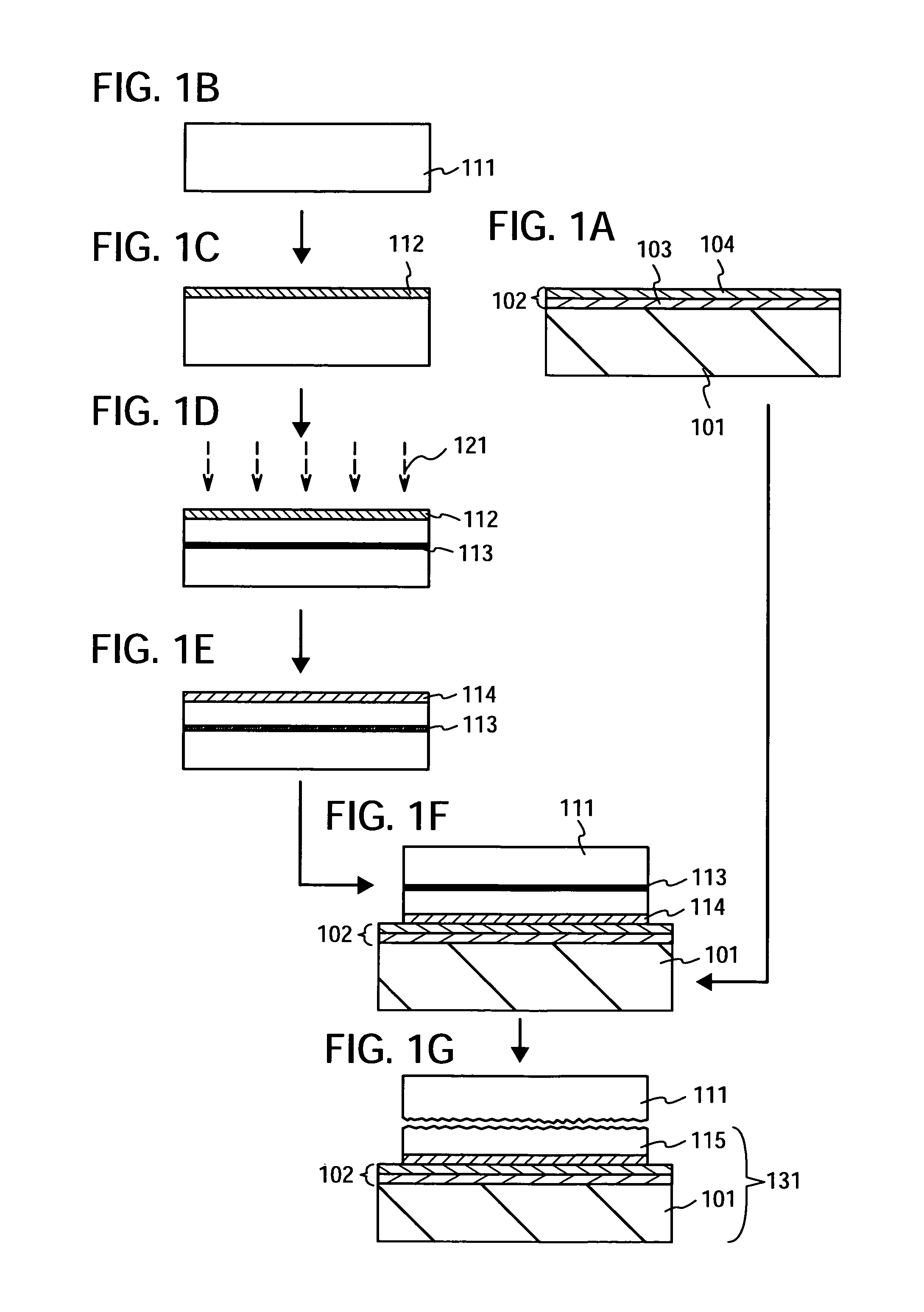Manufacturing method of SOI substrate and manufacturing method of semiconductor device
a manufacturing method and semiconductor technology, applied in the direction of semiconductor devices, electrical equipment, basic electric elements, etc., can solve the problems of glass substrate having low heat resistance, process temperature limit in manufacturing transistors, and soi substrate after bonding a single-crystalline silicon layer cannot be heated at a temperature, etc., to achieve high surface planarity, low heat resistance, and high surface planarity
- Summary
- Abstract
- Description
- Claims
- Application Information
AI Technical Summary
Benefits of technology
Problems solved by technology
Method used
Image
Examples
embodiment mode 1
[0070]FIGS. 1A to 2C are cross-sectional views showing an example of a manufacturing method of an SOI substrate. With reference to FIGS. 1A to 2C, an example of a manufacturing method of an SOI substrate is described.
[0071]As shown in FIG. 1A, a base substrate of an SOI substrate 101 is prepared. As the base substrate 101, a light-transmitting glass substrate used for the products of electronics industry such as a liquid crystal display device can be used. It is preferable to use a glass substrate having a coefficient of thermal expansion of equal to or higher than 25×10−7 / ° C. and equal to or lower than 50×10−7 / ° C. (preferably, equal to or higher than 30×10−7 / ° C. and equal to or lower than 40×10−7 / ° C.) and a strain point equal to or higher than 580° C. and equal to or lower than 680° C. (preferably, equal to or higher than 600° C. and equal to or lower than 680° C.) in terms of heat resistance, cost, and the like. Further, a non-alkali glass substrate is preferable as the glass ...
embodiment mode 2
[0119]FIGS. 3A to 4C are cross-sectional views showing an example of a manufacturing method of an SOI substrate. Hereinafter, the example of the manufacturing method of an SOI substrate is described with reference to FIGS. 3A to 4C.
[0120]As the above description with FIG. 1A, the base substrate 101 to be a base substrate of an SOI substrate is prepared. FIG. 3A is a cross-sectional view of the base substrate 101. As described with FIG. 1B, the semiconductor substrate 111 is prepared. FIG. 3B is a cross-sectional view of the semiconductor substrate 111.
[0121]The semiconductor substrate 111 is washed to be clean. Then, as shown in FIG. 3C, an insulating layer 116 is formed on an upper surface of the semiconductor substrate 111. The insulating layer 116 has a single-layer structure or a multilayer structure of two or more layers. The thickness of the insulating layer 116 can be equal to or greater than 10 nm and equal to or less than 400 nm.
[0122]As a film which forms the insulating la...
embodiment mode 3
[0143]FIGS. 5A to 6C are cross-sectional views showing an example of a manufacturing method of an SOI substrate. With reference to FIGS. 5A to 6C, the example of the manufacturing method of an SOI substrate will be described.
[0144]As the description with FIG. 1A, the base substrate 101 to be a base substrate of an SOI substrate is prepared, and the insulating layer 102 is formed over the base substrate. In this embodiment also, the insulating layer 102 is a film with a two-layer structure including the silicon nitride oxide film 103 and the silicon oxynitride film 104. Next, as shown in FIG. 5A, the bonding layer 105 is formed over the insulating layer 102. This bonding layer 105 can be formed similarly to the bonding layer 114 formed over the semiconductor substrate 111.
[0145]Next, FIGS. 5B to 5D are cross-sectional views showing the same steps as FIGS. 1B to 1D. As described in Embodiment Mode 1, the protective film 112 is formed over the semiconductor substrate 111, and the ion i...
PUM
| Property | Measurement | Unit |
|---|---|---|
| thickness | aaaaa | aaaaa |
| heat resistance | aaaaa | aaaaa |
| heat resistance temperature | aaaaa | aaaaa |
Abstract
Description
Claims
Application Information
 Login to View More
Login to View More - R&D
- Intellectual Property
- Life Sciences
- Materials
- Tech Scout
- Unparalleled Data Quality
- Higher Quality Content
- 60% Fewer Hallucinations
Browse by: Latest US Patents, China's latest patents, Technical Efficacy Thesaurus, Application Domain, Technology Topic, Popular Technical Reports.
© 2025 PatSnap. All rights reserved.Legal|Privacy policy|Modern Slavery Act Transparency Statement|Sitemap|About US| Contact US: help@patsnap.com



